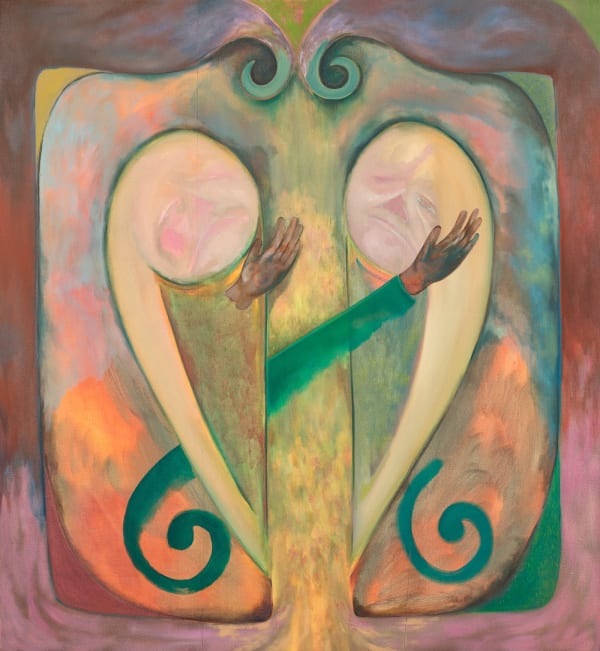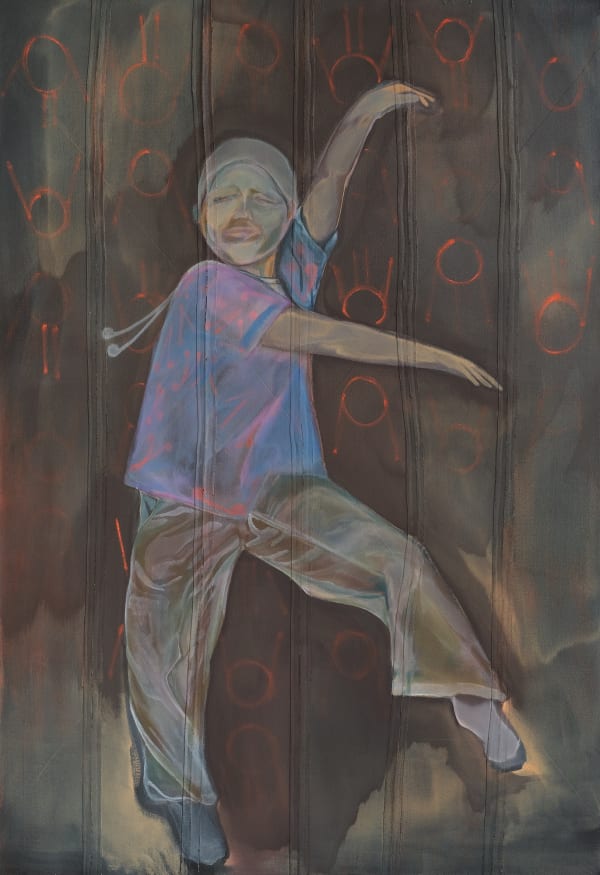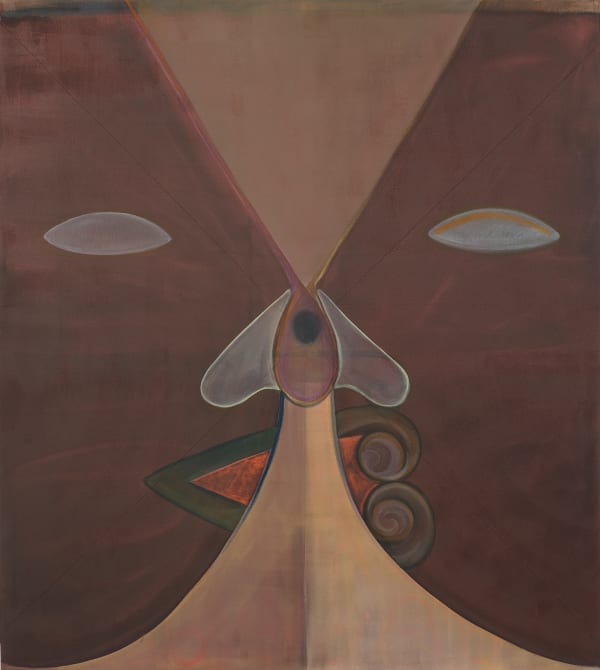Hannah Ireland, Tossing & Turning, Aotearoa Art Fair
Jhana Millers is excited to participate in the Aotearoa Art Fair at the Viaduct Events Centre from 18-21 April. For this year’s Fair, we are presenting a solo exhibition of new paintings by Hannah Ireland (Ngāti Hine, Ngāpuhi) 'Tossing & Turning'.
Sharing ways of working that feel vulnerable and confident in tandem, this body of work by Hannah Ireland signals a new chapter.
Hannah’s practice has been moving with incredible momentum over the past three years. Accumulating numerous exhibitions and awards, she has become recognisable for her haunting, slippery, and murky figures on glass, often using repurposed window frames as supports.
This new series of works sees Hannah stepping away from this mode of making, choosing canvas and paint to continue the impetus into a new space. Incorporating motifs and patterns as an exploration and expression of her whakapapa, 'Tossing & Turning' signifies the maker digging down to see what is to be uncovered.
A printed catalogue, and an essay by Zoe Black, Deputy Director at Objectspace, will accompany the exhibition.
Hannah Ireland is an early career artist from Tāmaki Makaurau. She holds a Bachelor of Arts (Psychology) and a Bachelor of Fine Arts from the University of Auckland. Ireland won the Supreme award at the Molly Morpeth Canaday Awards in Whakatane in 2021. She recently had a solo exhibition at Te Uru Waitakere Contemporary gallery and work included in Strange Friends at The Dowse Art Museum in Lower Hutt. Ireland is included in an upcoming exhibition at The Auckland Art Gallery opening mid 2024. Her work is in the collection of The Dowse Art Museum.
- Aotearoa Art Fair, 18-21 April,
- Booth G06, Viaduct Events Centre,
- Artist Talk, with Zoe Black 12.30PM, Saturday 20 April
Tossing & Turning
Ko wai au?
Hannah Ireland and I share whakapapa back to Te Tai Tokerau, to Ngāti Hine and to ancestors not known (yet). We both come from whānau whose connections to and knowledge of this whakapapa has been disconnected - through urban migration, living circumstances and years of staying in the city from an idea it could bring a ‘good’ / ‘well-off’ / different life.
Both Hannah and I also share current journeys of reconnection. It is a daunting task, owning the embarrassment of what you don’t know, asking your whānau to step into history they may not want to and craving a future where the uncomfortable feelings have dissipated.
This journey is common for a lot of us in this city. Our generation is approaching Māoritanga with a different attitude. Thanks to the mahi and resilience of our tīpuna recognising our whakapapa feels urgent and necessary. We are all going about it in different ways – some dipping toes, others taking the plunge headfirst. For myself and many around me, making has been a powerful method to confront and articulate our places in this world. In Tossing & Turning I see Hannah using her making as an opportunity to wade into these waters.
Hannah’s initial commentary on this series of paintings focuses on her visual vocabulary. She describes a rummaging / digging / uncovering of new methods of representation, still with a focus on the figure but now expressing some forms using reduced shapes. Hannah talks about her process as her pulling many threads together. Intuiting one thought then another, using her paintings to work through how she can articulate the multi-faceted way she understands her subjects / herself / where she stands here and now.
She begins with drawing. Her sketches accrue rapidly and are then sorted, selected and scaled onto the canvas. When we meet in her studio, the resulting paintings are large and stacked four or five deep. Fifteen completed over four months.
The generous scale of the canvases are a departure from her familiar glass supports. Hannah terms the glass as a ‘footnote’ in her practice – a moment where she was drawn to that particular way of working for the forced slowing of her process and the ability to play with the reveal and conceal her layered technique allowed. Now, working on canvas, there’s no need to wait for the pigment to settle – she can work the surface at an accelerated pace.
As a counterpoint to the swiftness the fabric permits and in an attempt to pull back some time, each canvas has been disrupted through cuts and stitching. Hannah generates interventions on the plane that she then reforms – creating patterns and indentations that later come to influence the compositions. The sewing acknowledges more of her hand within the works, upsetting the perfect flat surface through patchwork modifications.
As a body of work, these paintings reveal themselves slowly. The transitions between each are apparent as Hannah continues to work through her visual language and hones her approach. Figures appear out of the haze, shapes are observed and patterns form. Some of her figures are boldly reductive and pared back, others employing her recognisable expressive marks to offer a glimpse at lips, nose and eyes.
Her earlier works on glass would often focus on a solo figure, here she has opened up the space to groups and pairs, often in conversation. There are a number where tenderness is shown in the interaction – arms wrap around each other and hands offer support. There is a sense of nurturing, the figures cradling onto each other in space.
She has brought in koru as a repeating motif and perhaps it will become an enduring feature of her painting vocabulary. Koru pepper the canvases – spiralling out and connecting with each other as they speak across the series. We talk about the inclusion of patterns recognisably Māori. There were some (poutama, tukutuku panels) in previous works but they featured primarily as backdrops. This is a leap into a new space where she is allowing her whakapapa to inform how things are manifesting in the paint.
She acknowledges her hesitation in using koru. Again, like many of us who haven’t grown up in te ao Māori, there’s a sense of exposure activating a relationship with culture without the reo, without deep mātauranga and understanding of tikanga. We are constantly checking in, not wanting to offend and not wanting to get it wrong. We talk about these works as a marker in time, where Hannah is testing how she can acknowledge the path to whānau reconnection. Across the series koru acts as a departure point and an intuitive beginning for feeling out what is working to move her visual language forward. Traditionally koru represent new life, strength and growth. Here it is an apt symbol to ground this territory change.
Hannah’s practice has been moving with incredible momentum over the past three years. Moving away from the haunting / slippery / comedic / nostalgic figures on glass, this body of work feels vulnerable and confident in tandem. Tossing & Turning signifies the maker digging down to see what is yet to be uncovered and I like to think that Hannah’s tīpuna are encouraging through her paintbrush, offering her a conduit to explore and understand her place.
Condensed and distilled
In tears and laughter
Welling deep within
The flowing springs
The seed uncurling
Sliding shoreward
On the sea’s curve … riding
The embryo of aroha
From KORU by Haare Williams
Text by Zoe Black



















